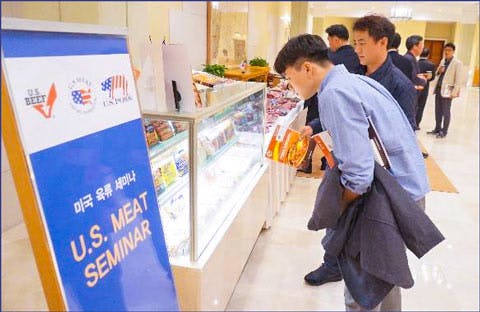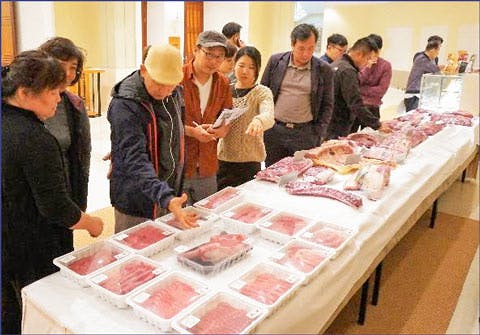U.S. Chilled Beef, Pork Focus of Seminar on South Korea’s Jeju Island
New ideas for U.S. chilled beef and pork for foodservice managers and retailers on dominated a U.S. meat seminar at Hotel Shilla on South Korea’s Jeju Island. The seminar, funded by the USDA Market Access Program (MAP), the Beef Checkoff Program and the National Pork Board, attracted key U.S. beef and pork suppliers interested in doing business in the region.

Attendees learned about the many advantages and uses for chilled U.S. beef and pork
USMEF chefs prepared various Korean, Chinese, Western and Japanese style U.S. beef and pork dishes using U.S. beef outside skirt, boneless short ribs, finger meat and brisket, as well as U.S. pork pulled pork, bacon and ham.
A U.S. beef and pork showcase was also part of the seminar, centered around a display of U.S. beef short ribs, chuck short ribs, brisket, chuck roll, short plate, petite tender, hanging tender, bone-in ribeye roll, short loin, shoulder clod, outside skirt, flap meat, flat iron, back ribs and tomahawk steak. U.S. pork cuts in the display were Boston butt, back ribs, spare ribs and processed pork items.

The U.S. meat seminar included presentations designed to introduce and educate those in Jeju Island’s foodservice and retail sectors about the quality of U.S. beef and pork
Jihae Yang, USMEF director in South Korea, said the seminar confirmed that U.S. beef and pork are in high demand on Jeju Island – and that improvements to the distribution channel could help move more U.S. product into the fast-growing tourist area.
“Jeju Island has had less exposure to U.S. beef and the distribution channel is not as firmly established as it is on Korea’s mainland,” said Yang. “This seminar was very helpful in getting both sides of the red meat supply chain together to meet and discuss business. At the same time, it allowed us to introduce various U.S. beef and pork items. Our goal was to increase the understanding of U.S. red meat and help importers and distributors recognize its competitiveness in the market.”

Foodservice managers, retailers and distributors attending the U.S. meat seminar saw many cuts of U.S. beef and pork on display
Jeju Island, the largest island in South Korea, attracted more than 15 million tourists last year. It has become Korea’s tourism hub and has added many luxury hotels and resorts over the past decade. Yang said the number of boutique hotels and restaurants has also rapidly increased, so USMEF expanded the invitation list for the seminar to include smaller private restaurants.
“Although traditional seafood and local black pork are still top trends in the Jeju Island restaurant scene, new trends such as burgers, sandwiches and steaks have the potential to increase demand for U.S. beef and pork,” she said.
The U.S. meat seminar, which attracted more than 70 of the area’s foodservice and retail professionals, was broken into three segments.
Segment 1: U.S. beef and pork industry overview
Alex Choi, USMEF assistant marketing manager in Korea, began with a look at the U.S. beef and pork industries, including production and prices. He passed on information on U.S. cattle and hog breeds, the USDA grading system and marketing programs and branded products in the Korean market.
Segment 2: U.S. chilled beef and pork
Junil Park, USMEF senior marketing manager in Korea, focused on production, distribution and handling of U.S. chilled beef and pork. He also discussed cuts recently introduced in the Korean market and offered merchandising suggestions.
Segment 3: Restaurant meat menu trends and marketing via mobile applications
Myeongheon Roh, co-founder of Mango Plate, a top restaurant recommendation mobile application and web portal site in Korea, was a guest presenter at the seminar on past, current and coming restaurant menu trends based on Mango Plate data. Mango Plate has more than 3 million users per month and an average of 35 million page views. The company also provides restaurant management and operations solutions.
At the end of the seminar, USMEF gave attendees sample packages of U.S. beef strip loin, shoulder clod, top blade and U.S. processed pork items. The idea, Yang explained, was for the attendees to take the samples back to their hotels or restaurants and discuss menu ideas with their chefs and staffs.
“This is a practical way of supplementing the information we shared during the seminar,” said Yang.
